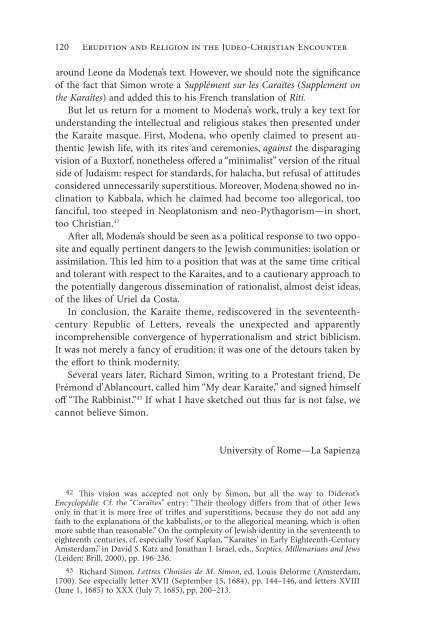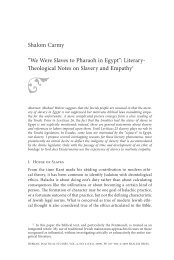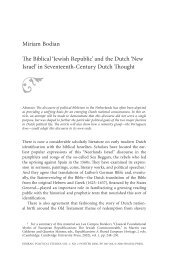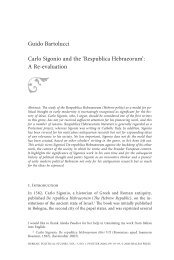download this article in pdf format - Hebraic Political Studies
download this article in pdf format - Hebraic Political Studies
download this article in pdf format - Hebraic Political Studies
Create successful ePaper yourself
Turn your PDF publications into a flip-book with our unique Google optimized e-Paper software.
120 ERUDITION AND RELIGION IN THE JUDEO-CHRISTIAN ENCOUNTER<br />
around Leone da Modena’s text. However, we should note the significance<br />
of the fact that Simon wrote a Supplément sur les Caraïtes (Supplement on<br />
the Karaites) and added <strong>this</strong> to his French translation of Riti.<br />
But let us return for a moment to Modena’s work, truly a key text for<br />
understand<strong>in</strong>g the <strong>in</strong>tellectual and religious stakes then presented under<br />
the Karaite masque. First, Modena, who openly claimed to present authentic<br />
Jewish life, with its rites and ceremonies, aga<strong>in</strong>st the disparag<strong>in</strong>g<br />
vision of a Buxtorf, nonetheless offered a “m<strong>in</strong>imalist” version of the ritual<br />
side of Judaism: respect for standards, for halacha, but refusal of attitudes<br />
considered unnecessarily superstitious. Moreover, Modena showed no <strong>in</strong>cl<strong>in</strong>ation<br />
to Kabbala, which he claimed had become too allegorical, too<br />
fanciful, too steeped <strong>in</strong> Neoplatonism and neo-Pythagorism—<strong>in</strong> short,<br />
too Christian. 42<br />
Aer all, Modena’s should be seen as a political response to two opposite<br />
and equally pert<strong>in</strong>ent dangers to the Jewish communities: isolation or<br />
assimilation. is led him to a position that was at the same time critical<br />
and tolerant with respect to the Karaites, and to a cautionary approach to<br />
the potentially dangerous dissem<strong>in</strong>ation of rationalist, almost deist ideas,<br />
of the likes of Uriel da Costa.<br />
In conclusion, the Karaite theme, rediscovered <strong>in</strong> the seventeenthcentury<br />
Republic of Letters, reveals the unexpected and apparently<br />
<strong>in</strong>comprehensible convergence of hyperrationalism and strict biblicism.<br />
It was not merely a fancy of erudition; it was one of the detours taken by<br />
the effort to th<strong>in</strong>k modernity.<br />
Several years later, Richard Simon, writ<strong>in</strong>g to a Protestant friend, De<br />
Frémond d’Ablancourt, called him “My dear Karaite,” and signed himself<br />
off “e Rabb<strong>in</strong>ist.” 43 If what I have sketched out thus far is not false, we<br />
cannot believe Simon.<br />
University of Rome—La Sapienza<br />
42 is vision was accepted not only by Simon, but all the way to Diderot’s<br />
Encyclopédie. Cf. the “Caraïtes” entry: “eir theology differ<br />
s from that of other Jews<br />
only <strong>in</strong> that it is more free of trifles and superstitions, because they do not add any<br />
faith to the explanations of the kabbalists, or to the allegorical mean<strong>in</strong>g, which is oen<br />
more subtle than reasonable.” On the complexity of Jewish identity <strong>in</strong> the seventeenth to<br />
eighteenth centuries, cf. especially Yosef Kaplan,<br />
“‘Karaites’ <strong>in</strong> Early Eighteenth-Century<br />
Amsterdam,” <strong>in</strong> David S. Katz and Jonathan I. Israel, eds., Sceptics, Millenarians and Jews<br />
(Leiden: Brill, 2000), pp. 196-236.<br />
43 Richard Simon, Lettres Choisies de M. Simon, ed. Louis Delorme (Amsterdam,<br />
1700). See especially letter XVII (September 15, 1684), pp. 144–146, and letters XVIII<br />
(June 1, 1685) to XXX (July 7, 1685), pp. 200–213.







